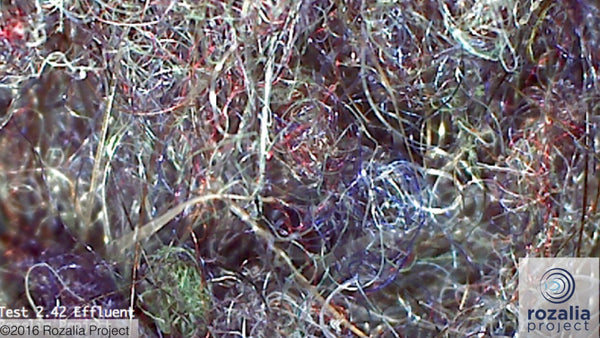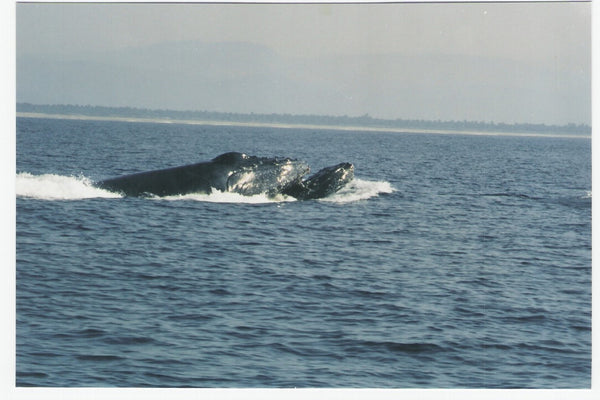Microfiber and the Whale
Whales are a delight to witness in the wild. They are slow and measured, their songs eerie yet soothing. There is a long-standing fascination with these ocean giants and it has inspired deep folklore and passionate love in every culture. February 20th is World Whale Day and this week, we are empowering Ocean Protectors to protect whales with everyday sustainable actions at home.

Photo Credit: Tegan Maxey
Whales under pressure
The blue whale is the largest whale in the world and the dwarf sperm whale is the smallest. With lifespans that can be over 100 years, long gestation periods and low birth rates, there are many dangers facing whale species all over the world.
Some commonly-discussed threats to whales include fishing gear entanglement, marine debris ingestion, competing with commercial fishing for food and ship strikes. However, the tiniest threat is one of the most important: microfiber.
Can microfiber hurt whales?
To explain how microfiber is a threat to whales, we first need to talk about persistent organic pollutants, or POPs. POPs are a class of pollution that can be made from natural processes, but are found in the environment primarily from human industry (including DDT and PCBs). These pollutants get into the environment from poor waste management practices or through the course of their use. When the effects of POPs were discovered and widely publicized, like in Rachel Carson’s Silent Spring, many were banned or regulated to reduce their release into the environment. However, the crux of POPs is the first “P”: persistent. Despite bans and regulations across the world, POPs of many origins are still leaking out of landfills and circulating around the ocean because they are very stable compounds and do not break down, or do so very slowly over decades or longer.

Now, you may be wondering why we shouldn’t be more concerned about the presence of POPs if they are everywhere in the ocean. If you scooped out a bucket of sea water, the concentration of POPs would most likely be undetectable, as would be the case with most ocean samples. That’s where plastic microfibers and other plastic marine debris comes into play.
Plastic is made from oil and has carbon molecule structures that attract the similar carbon structures in POP molecules. This attractive force is called oleophilicity and behaves like a magnet. Once in contact with each other, the POPs adhere to the microplastic surface like a sticker, collecting more and more over time as the plastic gets swirled around in the ocean currents.
Problems start brewing when sea creatures consume the plastic pieces covered in POPs. The POPs transfer from the surface of the plastic into the tissues of the sea creatures, even if the plastic itself is passed out of their digestive system. POPs get stored into body fat and will not metabolize out of animals in excretions. In small amounts, POPs may not cause any metabolic harm (like plankton or fish feeding only on plankton), but sea creatures higher on the food chain (like Orcas that hunt seals or predatory fish) that consume many more smaller creatures or other predators already containing elevated amounts of POPs will experience bioaccumulation, where the POP concentrations are multiplied many times over in their bodies - approximately 10x the levels of their prey.
POPs are endocrine disruptors and, in high enough concentrations, can cause metabolic and reproductive harm and even death. A prime example is the decline in Orca whale reproduction and calf survival. This trend has been linked to high POPs concentrations (specifically PCBs) in their blubber. Most concerning is that since the POPs are found in the fats of whales, this extends to the mother’s milk and calves are subjected to sudden high levels of POPs in their first year of life and the resulting mortality rate is sadly high. (Guardian, 2018)

A guiding light
While POPs and bioaccumulation create greater problems of endocrine disruption the higher you go in the food chain, this also means that even small improvements in the lowest level have compounding positive effects!
Our team is always optimistic about our ability to control the parts of a problem within our grasp to make progress toward meaningful change. Each garment in a load of laundry can create tens to hundreds of thousands of pieces of microfiber that end up in our wastewater and in our environment. With the simple act of tossing Cora Ball in our washing machines, we can decrease microfiber pollution by 31% and reduce the chances of POPs piggybacking their way into the food chain.
Join us and help keep our ocean cleaner for the plankton, fish, birds, and whales, one load of laundry at a time!
